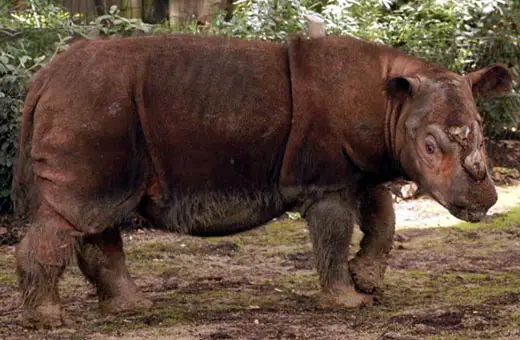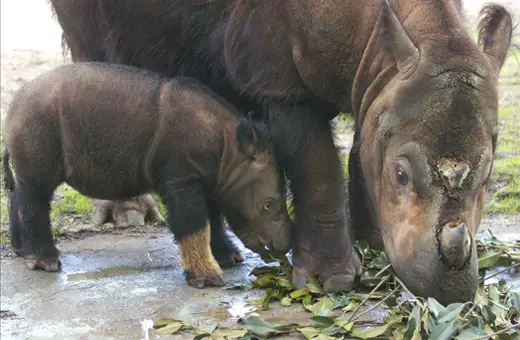Sumatran Rhinoceros
The Sumatran Rhinoceros is a two-horned rhinoceros that is also known as the ‘hairy rhino’ be cause it is covered in thin coarse hair from top to bottom. Currently classed as critically endangered the Sumatran Rhinoceros is another ground mammal that is on the verge of extinction thanks to human activity, specifically deforestation and serious poaching. The Sumatran Rhinoceros is found primarily in Indonesia, Malaysia and other areas of south-east Asia, this may seem fairly wide spread but in actuality there are estimated to only be around 250 -280 of these small rhinos left in the world covering the entirety of south east Asia.
The Sumatran Rhinoceros is believed to be closely related to rhinos outside of Asia with a common ancestor of the woolly rhinoceros which is now extinct. Once popular of all of south east Asia the Sumatran Rhinoceros is still found across south east Asia but is spread extremely thin and in small fragmented groups making re-population difficult.

Sumatran Rhinoceros in captivity
The Sumatran Rhinoceros is the smallest living rhino species, it is easily recognizable by its red/brown skin and covering of coarse thin hair. Another way to identify the Sumatran Rhinoceros is through its dual horns however in rare cases the second horn may be absent, this occurs more often in the female of the species.
Native to south east Asia the Sumatran Rhinoceros makes its home in forests and hilly areas when there is sufficient water near-by. The most common habitat of the Sumatran Rhinoceros is in tropical forests and mountain forests although common is a word badly suited for the Sumatran Rhinoceros. In the rhinos forest habitat the Sumatran Rhinoceros are most likely to spend their time in the lower forest areas where the is ample shrubbery and salt lick that is essential to the Sumatran Rhinoceros’s diet.

Feeding time with a youngster
The Sumatran Rhinoceros consumes up to 50kg of food every day which consists of shrubs, fruit, leaves, bark and vines – all plant products. Although the Sumatran Rhinoceros has a varied diet, particular favorites of the hairy rhinos are figs, bamboo, wild mango and of course salt lick which is absolutely essential for vitamin and mineral intake. The Sumatran Rhinoceros live alone and will only group up in breeding season, the rhinos spend most of their days relaxing in mud to keep cool and will go in search for food at cooler times of the day such as the twilight periods or even at night. Sumatran Rhinoceros can live up to 40 years and the female of the species will commonly give birth to one calf around every 3 – 4 years.


